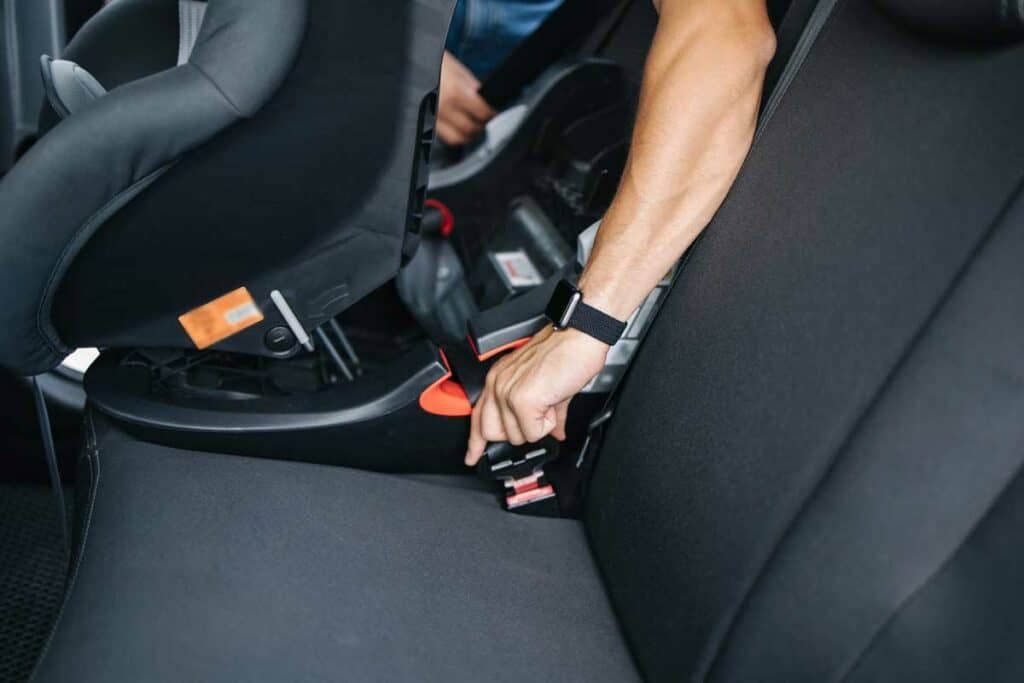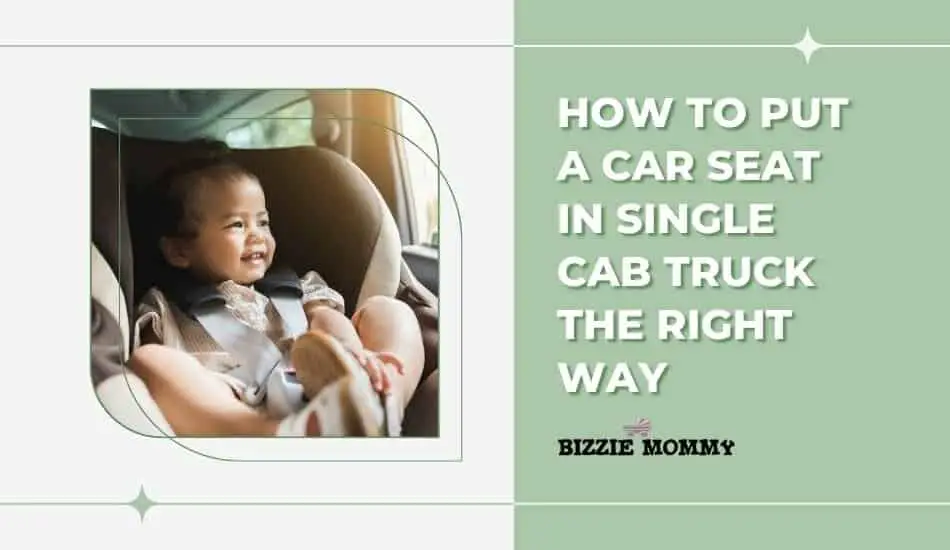Putting a car seat in a single cab truck is a heavily debated topic, mostly because of the potential dangers. The common perspective about this topic is that putting a car seat in the front of a truck can result in serious injury in case of an accident, and hence, it goes against the safety laws. A front seat installation is completely legal and safe if done properly.
National law states that if your truck does not have a back seat, it is okay to place a booster child seat in the front, but the seat must be 85% supported by the width of the truck. To properly fasten all forward-facing car seats, the truck has to have a top seat tether anchor, too. A car seat is permissible in a single cab vehicle. Children can travel in the front if they are secured or seated in a booster seat that is appropriate for their age bracket. Even so, there is no such thing as a single cab truck seat belt law. The only legislation you should observe is one that pertains to kids’ safety in the front seat based on their age.
If at all possible, make sure that kids ride in the back of a vehicle. When there’s an operational passenger airbag, never install a rear-facing booster seat in front. If you must, ensure that the child’s seat is as far away from the front as possible, that the booster seat is firmly fastened, and that the child is properly secured by the belt or seat strap, keeping the child as far from the dashboard as possible.
Check with the car manufacturer about how far the airbag extends when it deploys and if it is okay to be using a kid seat. In contrast to the front airbags, side airbags often activate as a drape and defend the head. They are less effective than front airbags. They should not endanger a kid in a rear-facing child seat.
It is not legal to use a rear-facing car seat in an airbag-protected passenger seat. The activation of an airbag when in the presence of a rear-facing child seat can result in significant damage or perhaps even death to the kid. Not every brand or manufacturer uses the same mechanism or procedure to deactivate the passenger airbag. You must read the owner’s manual, which will detail all of the processes that must be followed. If you cannot deactivate the airbags, you must secure the seat anchors to the tethers.
The top-tether sign indicates the location of top-tether anchors in your vehicle. The insignia may not be as visible in certain vehicles as it is in others, but now you’ll understand what you’re searching for. Always refer to your owner’s manual for specific instructions as to how to secure the top tether for every rear-seat arrangement.
Many people believe that the top tether should only ever be deployed when trying to install forward-facing car seats that have lower anchors. The misconception may stem from the abbreviation LATCH, which stands for Lower Anchors and Tethers for Children. But in reality, all forward-facing seat installations, whether secured by a tether or a belt, should have top tethers.
Ignore The Judgement About Having A Car Seat In Your Single Cab Truck
It is completely legal to install a baby car seat inside a single cab truck; however, the single cab must provide an on/off button control for the airbags. Whenever the infant car seat is mounted, and particularly whenever the baby is inside the vehicle, the driver has to make sure that the airbags are off.
According to traffic officials, the car seat must also be fitted in a rear-facing posture, and another person must also be present in the truck anytime the kid is being carried with the infant seat in the center.
Ways To Safely Put A Car Seat In A Single Cab Truck
Although the back seat would be the safest area for a child, not every truck offers that choice. If the booster seat is not compatible with the rear seat of your vehicle, or if your truck lacks a back-seat space, you can legally put the booster chair in the front row. There are two ways to do this:
Rear Facing Car Seat With Air Bag Off
Your life may be saved by an active airbag. However, they are a terrible mix for small babies. All modern automobiles come standard with front airbags. Airbags perform effectively to protect teens and adults if used in conjunction with seat belts, but they may be extremely harmful to children, particularly those traveling in rear-facing seats.
Babies in rear-facing seats should sit in the back seat if the vehicle includes a front passenger airbag. Even in a low-speed collision, the airbag may discharge, impact the vehicle seat, and inflict severe brain damage or death.
Turn the airbag off
Check to see if it is possible to disable the airbag. This option is not available in many vehicles, particularly older models. If the vehicle lacks a switch to enable or disable the driver’s airbag, the airbag is always active. If the passenger airbag cannot be deactivated, it is suggested that all kids sit in the back seat.
Sometimes, the electronic seatbelt tensioner on the passenger side also becomes inactive if the passenger airbag is disengaged. Drivers who put a rear facing car seat at the front of a vehicle with an activated airbag face a fine. If you are detected, you will get at least two or three penalty points on your license. When a child is not traveling, and the seat has just a passenger, ensure to reactivate the airbag.
Forward Facing With Top Tether
Incorrect booster car seat installation occurs in up to 60% of cases. In fact, Safe Kids discovered that 64 percent of parents having a kid in a forward-facing car seat did not use the tether whatsoever in 2015-2016.
Tether anchors are a must:
When you put a forward-facing harness car seat (or change a rear-facing seat to the forward seat), you need to use a top tether. Top tethers are designed to protect forward-facing seats from rolling forward in the case of an accident. A seat can be flung four to six inches forward if the tether is not secured. That number might not look alarming, but it might cause a child’s head to crash into the front seat or even the dashboard, resulting in catastrophic head damage.
Top tethers can be used in conjunction either with a belt or a LATCH installation. LATCH is an acronym for Lower Anchors and Tethers for Children. It refers to the fastening of a car seat by attaching specific straps to metal anchors in the vehicle.
LATCH isn’t always safer than a seat belt setup, but it varies with the vehicle, the positioning of the belts or anchors, the kind of car seat, and other factors. The key is that top tethers must be utilized on a strapped, forward-facing seat.
Types of Top Tethers And How To Find Them In Your Truck

If you’re not sure where the tether anchor is in your truck, check your owner’s handbook. Tether anchors will be positioned somewhere behind the rear seat in all cars made after 2001.
Behind the Seat Belts
The tether anchor is usually located behind the truck’s seat. To locate the anchor, you may have to pull the seat down. While this might make fitting the car seat more difficult, it is needed to protect your child while traveling.
Webbing Loops
Webbing loops may be used in certain trucks. These can be found behind the vehicle’s head. Thread the tether around the loop next to the headrest, then secure the anchor with the webbing loop before the middle seat’s head.
Next, without closing it completely, take up part of the slack. Finish attaching the baby carrier, whether using LATCH or a belt, and then cut the remaining slack from the tether. Slip the excess tether beneath the seat’s headrest once done.
Loops behind the seat
The tether is often passed through a webbing loop, such as the one described above, and then fastened to a seat loop right behind the passenger seat or the neighboring outboard spot.
Once your child’s seat has been linked, placement is much like it would have been in a car.
Free Car Seat Installation Inspection In Your Local Area
Each of us wants to make sure our kids are secure. Fitting a baby carrier for a smaller kid or a baby might be difficult. According to AAA as well as the National Safety Council, 52% to 84% of child restraints are misused. The proportion changes depending on the study. Make sure to refer to child passenger safety (CPS) professionals in your area who can inspect your car seats for proper installation to avoid any issues.
What Is A Certified Passenger Safety Technician (CPS Technician)?
Child Passenger Safety Technicians teach parents and guardians how to install car seats appropriately. CPS technicians give specific training on how to correctly place a car seat inside a vehicle and secure a kid in a car seat.
They are car seat specialists who have completed a 40-hour course based on a curriculum developed by the NHTSA in partnership with the National CPS Board and Safe Kids Worldwide. During the lesson, they learn about car seats, installation alternatives, vehicle variances, harnessing methods, and other topics.
Components of inspection:
Confirm that the child has a suitable seat considering their age, weight, height, and the truck they will be traveling in.
Teach the parents, caregivers, and anyone else who would be driving the kid the best techniques to use while mounting the car seat.
Show how to properly fasten a kid in a car seat.
Look for any product warnings, safety concerns, or defects.
Check if the booster chair and the truck are compatible.
Provide more information about other agencies’ child safety initiatives.
Safety Comes First
Always remember that the safety of your child is the first priority under any circumstance. If possible, make sure your kids travel in the back seat, but if you must put them up front, take precautions. Remember to disable airbags if the child’s car seat is rear facing. If it is front facing, make sure to use a LATCH system or a seat belt to hold the seat in place with a car seat tether. Consult the vehicle manual for safely installing car seats and drive carefully, too.

